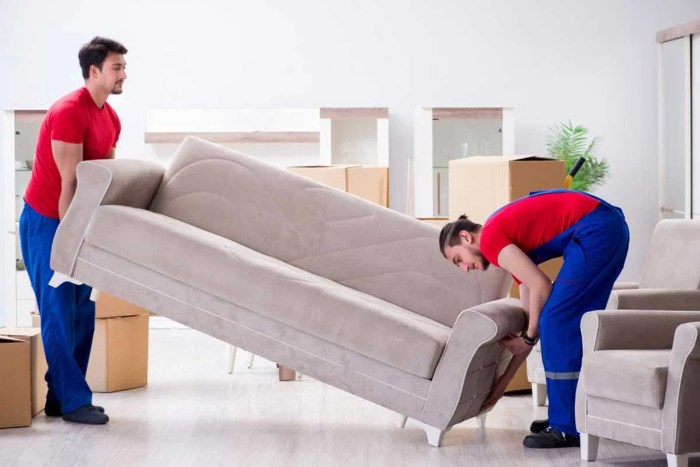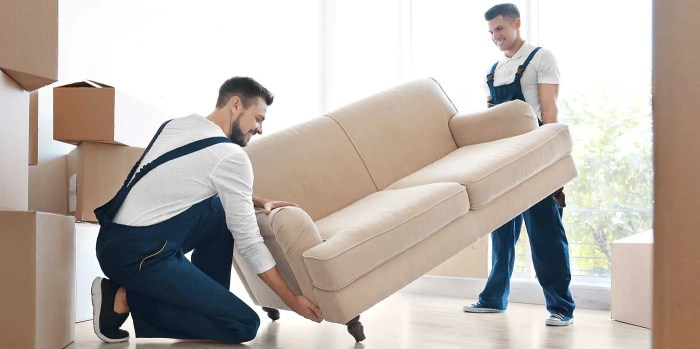Help with moving furniture can make all the difference in a successful relocation. Whether you’re hiring professional movers or tackling the task yourself, there are essential tips and tricks to ensure a smooth and stress-free experience. Dive into this comprehensive guide to discover everything you need to know about moving furniture, from planning to execution.
From choosing the right moving company to packing furniture safely, assembling it correctly, and even disposing of old pieces responsibly, this guide covers all aspects of furniture handling. So, whether you’re moving across town or just rearranging your living room, let’s get started on making your furniture move a breeze.
Moving Furniture Services
Moving furniture can be a daunting task, especially if you have a lot of heavy or bulky items. That’s where moving furniture services come in. These services can take the hassle out of moving, and they can also help you save time and money.
For a hassle-free relocation experience, enlisting the assistance of furniture shippers can prove invaluable. These professionals specialize in handling the transportation of your precious belongings, ensuring their safe arrival at your new abode. Whether you’re moving across town or across the country, furniture shippers offer tailored solutions to meet your specific needs, ensuring a seamless transition during your relocation.
There are a variety of moving furniture services available, from full-service moves to hourly rates. Full-service moves include everything from packing and loading your belongings to transporting them to your new home and unloading them. Hourly rates are a good option if you only need help with certain aspects of your move, such as loading or unloading.
Benefits of Hiring Professional Movers
- Save time and energy. Moving is a lot of work, and it can be exhausting. Hiring professional movers can take the stress out of moving, and it can free up your time to focus on other things.
- Protect your belongings. Professional movers are experienced in handling furniture and other belongings, and they know how to pack and transport them safely.
- Get the job done right. Professional movers are trained to move furniture efficiently and safely, and they will make sure your belongings are delivered to your new home in one piece.
Tips for Choosing the Right Moving Company
- Get recommendations from friends or family. If you know someone who has recently moved, ask them for recommendations for a moving company.
- Read online reviews. There are a number of websites where you can read reviews of moving companies.
- Get quotes from multiple companies. Once you have a few companies in mind, get quotes from each one. Be sure to compare the prices, services, and availability.
- Make sure the company is licensed and insured. This will protect you in case of any accidents or damage to your belongings.
DIY Moving Furniture

Moving furniture can be a daunting task, but it can be done safely and easily with the right preparation and precautions. Here’s a step-by-step guide to help you move furniture like a pro:
Before you start moving furniture, it’s important to gather the right tools and equipment. You’ll need:
- Moving blankets or furniture pads
- Furniture dolly or hand truck
- Ratchet straps or bungee cords
- Screwdriver or drill
- Wrench or socket set
- Level
Safety Precautions
Moving furniture can be dangerous if you’re not careful. Here are some safety precautions to keep in mind:
- Always lift with your legs, not your back.
- Wear sturdy shoes and gloves.
- Clear a path before you start moving furniture.
- Don’t overload the dolly or hand truck.
- Secure furniture to the dolly or hand truck with ratchet straps or bungee cords.
- Be aware of your surroundings and watch for obstacles.
- If you’re moving heavy furniture, get help from a friend or family member.
Packing and Unpacking Furniture

Properly packing and unpacking furniture is crucial to prevent damage and ensure a smooth move.
Packing Furniture
- Disassemble furniture whenever possible.This makes it easier to pack and transport, reducing the risk of damage.
- Use sturdy boxes.Double-walled boxes are ideal for heavy furniture, while smaller boxes can be used for lighter items.
- Wrap furniture in protective materials.Bubble wrap, packing paper, or blankets can protect furniture from scratches and dents.
- Fill empty spaces in boxes.Crumpled newspaper or packing peanuts can prevent items from shifting during transit.
Unpacking Furniture
- Unpack furniture in a well-lit area.This will help you identify any damage that may have occurred during transit.
- Remove packing materials carefully.Use scissors or a utility knife to avoid damaging furniture.
- Reassemble furniture according to the manufacturer’s instructions.This will ensure that it is properly assembled and stable.
- Inspect furniture for any damage.If you find any damage, contact the moving company or insurance provider immediately.
Furniture Assembly and Disassembly
Furniture assembly and disassembly are essential skills for anyone who moves frequently or enjoys DIY projects. Understanding the different methods and techniques can save you time, effort, and potential damage to your furniture.
Tools and Techniques for Furniture Assembly
Before starting any assembly, gather the necessary tools and materials, including a screwdriver, Allen wrench, hammer, nails, and wood glue. Read the assembly instructions carefully and follow them step-by-step. Use a level to ensure the furniture is level and stable.
Tips for Safe and Correct Assembly
- Always wear safety glasses when using power tools.
- Tighten screws and bolts securely, but avoid overtightening.
- Use wood glue to reinforce joints and prevent loosening.
- Test the furniture’s stability before using it.
- Keep assembly instructions for future reference or disassembly.
Furniture Care and Maintenance
Furniture is a significant investment, and proper care and maintenance can prolong its lifespan and preserve its beauty. Here are some essential tips to keep your furniture looking its best:
Regular cleaning is crucial to remove dust, dirt, and other particles that can accumulate over time. Use a soft, clean cloth and avoid abrasive materials that can scratch the finish. For spills, blot immediately with a clean, dry cloth. Do not rub, as this can spread the spill and damage the fabric.
Furniture Finishes
Different furniture finishes require specific care methods. Here are some common types:
- Wood finishes: Wood finishes vary widely, so it’s important to determine the type of finish before cleaning. Waxed or oiled finishes can be cleaned with a soft, dry cloth. Lacquered or polyurethane finishes can be cleaned with a damp cloth and mild soap.
- Upholstery fabrics: Upholstery fabrics should be vacuumed regularly to remove dust and dirt. For spills, blot immediately with a clean, dry cloth. Do not rub, as this can damage the fabric. Some fabrics may require professional cleaning.
- Leather finishes: Leather finishes require special care to prevent cracking and fading. Clean leather with a soft, dry cloth and avoid using harsh chemicals. Condition leather regularly with a leather conditioner to keep it supple.
Regular Maintenance
Regular maintenance is essential to keep furniture in good condition. Here are some tips:
- Inspect furniture regularlyfor any signs of damage or wear. Tighten any loose screws or bolts.
- Move furniture occasionallyto prevent uneven wear on floors and carpets.
- Protect furniture from sunlight, as prolonged exposure can fade fabrics and damage finishes.
- Use coasters under glasses and cupsto prevent stains and scratches on tabletops.
Furniture Disposal
Disposing of old furniture can be a challenge, but it’s important to do so responsibly. There are a number of different options available, and the best choice for you will depend on the type of furniture you have, your budget, and your environmental concerns.
Donating Furniture
Donating your old furniture is a great way to give it a new life and help those in need. There are many organizations that accept furniture donations, including charities, thrift stores, and homeless shelters. Before you donate your furniture, be sure to clean it and make any necessary repairs.
You should also check with the organization to see if they have any specific requirements for donations.
Recycling Furniture
Recycling furniture is another great option, especially for furniture that is made from wood, metal, or plastic. There are a number of companies that specialize in recycling furniture, and they can often pick up your furniture from your home or office.
When you recycle furniture, it is broken down into its component materials and then used to create new products.
When you’re tackling the daunting task of moving furniture, don’t forget that haverty furniture offers exceptional moving services. Their experienced professionals will ensure your prized possessions are transported safely and efficiently. Whether it’s a grand piano or a delicate heirloom, they’ll handle every item with the utmost care, making your move a stress-free experience.
Landfilling Furniture
Landfilling furniture is the least environmentally friendly option, but it is often the cheapest and easiest. When you landfill furniture, it is buried in a landfill and will decompose over time. However, landfilling furniture can release harmful chemicals into the environment, and it can also take up valuable space.
Moving furniture can be a real hassle, especially if you’re doing it on your own. That’s where furniture shipment comes in. With furniture shipment, you can have your furniture picked up and delivered to your new home without having to lift a finger.
This can save you a lot of time and energy, and it can also help to prevent damage to your furniture. If you’re looking for a hassle-free way to move your furniture, then furniture shipment is the perfect solution for you.
Environmental Impact of Furniture Disposal
The environmental impact of furniture disposal is a serious concern. Landfilling furniture can release harmful chemicals into the environment, and it can also take up valuable space. Recycling furniture is a more environmentally friendly option, but it is not always possible.
Donating furniture is the best option for the environment, but it is not always possible to find an organization that will accept your furniture.
Tips for Donating or Recycling Furniture, Help with moving furniture
Here are a few tips for donating or recycling furniture:
- Clean your furniture and make any necessary repairs before donating or recycling it.
- Check with the organization or company to see if they have any specific requirements for donations or recycling.
- Be prepared to transport your furniture to the organization or company yourself.
- Consider donating or recycling your furniture to a local organization or company to reduce the environmental impact.
End of Discussion

Moving furniture doesn’t have to be a daunting task. By following the expert tips and advice Artikeld in this guide, you can ensure your furniture arrives at its new destination safely and efficiently. Whether you opt for professional moving services or prefer to DIY, remember to prioritize safety, plan thoroughly, and take care of your furniture throughout the process.
With the right approach, you can make your furniture move a success.
Top FAQs: Help With Moving Furniture
How can I choose the right moving company?
Look for companies with experience, positive reviews, and proper licensing and insurance. Get quotes from multiple movers and compare their services and prices.
What are the essential tools for moving furniture?
Dolly, furniture pads, straps, screwdrivers, and a tool kit with basic tools like a hammer and wrench.
How do I pack furniture safely?
Use sturdy boxes, bubble wrap, packing paper, and foam peanuts. Disassemble furniture when possible and label all pieces clearly.